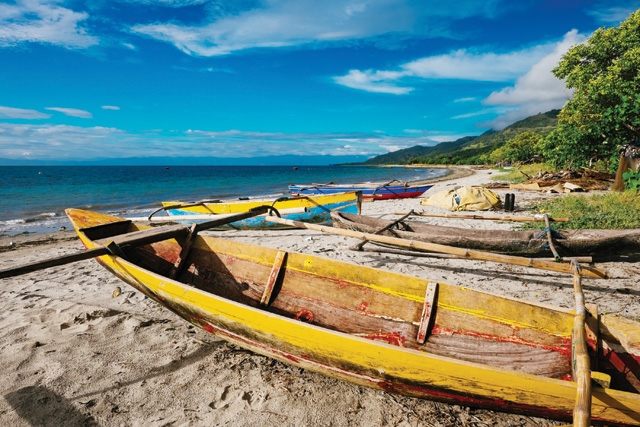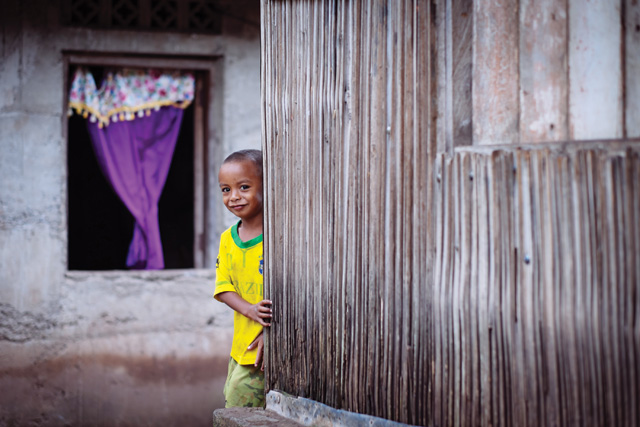Photography by Bernardo Salce
Each morning, not long after the sun crests over Dili, throngs of young boys and men wade into the clear blue sea with rudimentary fishing gear. Most have nothing more than a tattered line attached to a Coca-Cola can, but they reel in fish the length of their forearms. The more prosperous fishermen chug further out to sea in wooden boats with noisy outboard motors. As lunchtime rolls around, the same boys and men can be seen walking the capital’s streets with their morning catch hanging from long poles they carry over their shoulders.

The capital of Timor-Leste is unlike any other in Southeast Asia. With a population of just under 200,000, Dili has the look and feel of a small provincial town. There are no skyscrapers or high-rises – it is hard to get any kind of vertiginous feeling here – and the vast majority of its buildings are one-storey breezeblock affairs with candy-coloured outer walls. Arriving by airplane, one can fully appreciate the small stature of this city; its northern limits disappear quickly into emerald green forests while its southern reaches vanish into the vast blue sea.
“It’s the kind of place where everyone knows everyone,” says Platao Lebre, an affable local tour guide in his early 20s who speaks with a calmness that’s in keeping with his hometown.
Platao picks us up from our hotel on the outskirts of the capital in the early morning and in no time we are cruising along Dili’s coastal road. It is a long, winding strip that intermittently switches between gravel and tarmac and bends at sharp right angles between the peaceful ocean on one side and overhanging cliffs on the other before passing a stretch of beachside shacks selling fresh fish and vegetables, an indication of the country’s ‘buy local’ initiative.
Dili has an enviable pace of life. Along the palm tree-flanked seafront promenade, young men and women hang around in groups smoking cheap cigarettes and listening to Brazilian pop blaring from parked, brightly coloured taxis. Younger children ride up and down the pavement on bicycles and tear around dusty football pitches on foot.
As with so much of Dili, it is a halcyon scene. And, of course, it is one that can be so easily romanticised by an outsider. “There is much poverty and unemployment here,” Platao says, adding that almost half of the young men in the capital, many of whom hang out by the beach every day, do not have jobs. “We hope that the tourism industry could provide a lot for the country.”
Indeed, the government has identified tourism as a key source of revenue and one of the ways it can diversify its oil- and gas-dependent economy. This was laid out in its Strategic Development Plan, a 20-year economic blueprint published five years ago. But progress has been slow. In 2005, the New York Times ran a travel story with the headline: “East Timor Has Beaches Like Bali’s but Few Tourists”. A decade on and little has changed. The beaches and sea are still as pristine and as empty as they ever were. The majority are so unspoiled, in fact, that a ten-minute drive outside of the city centre sees stretches of crystal blue water that one can simply wade into and snorkel – alone, except for the abundance of marine life.

Yet tourist arrival numbers have been increasing. They grew almost five-fold between 2006 and 2012, according to the latest statistics from the World Tourism Organisation. However, in 2012 Timor-Leste welcomed fewer than 50,000 visitors – about 2% of the number who went to Bali in the same year.
Developing the tourism industry is something Platao feels strongly about.
“We want to become like Bangkok, Singapore or Bali,” he says, as we turn off the coastal road and head into the centre of the city. “We need more tourists, like those places.”
“Have you ever been to any of these places?” I ask.
He shakes his head and admits he has only spent a short period of time outside Timor-Leste, in Indonesia and Australia. I comment, trying not to be condescending, that he should be careful for what he wishes for.
“Why?” he asks.
I attempt to articulate that his country seems to be in a Catch-22 situation. It is exactly what differentiates Timor-Leste from the places he mentions that makes it so attractive as a destination: the lack of tourists, its unspoilt natural beauty, the absence of ‘backpacker streets’ and no prostitution or drug industries to cater to seedy foreigners. If it attempted these things to encourage the increasing numbers of tourists, its greatest assets may well be lost.

Platao shrugs off my concerns – “Maybe, maybe,” he says – as we pull up outside the first stop on our improvised itinerary. The Timorese Resistance Archive and Museum is a must-see for history buffs. Opened in 2005, it charts the story of Timor-Leste right back to before the Portuguese colonisers arrived in the 16th Century. The museum tells the story of the Indonesian occupation that took place between 1975 and 1999, during which time more than 100,000 East Timorese, about a third of the population, are estimated to have died.
The government’s Strategic Development Plan identifies historical tourism as one of the country’s main selling points – and there is no shortage of it in Dili. After a quick tour of the museum, we head to the Santa Cruz cemetery. Here, in November 1991, Indonesian forces massacred more than 250 people during a funeral procession for a pro-independence demonstrator. Today, the cemetery is a lustrously coloured collection of headstones and crosses that stand at odd angles.
Platao ambles to the centre of the cemetery, tiptoeing uneasily between the graves. Standing beside the headstone of Sebastião Gomes – the martyred demonstrator – Platao points to a small concrete hut. “During the massacre, people hid in there. Then the Indonesians came in and opened fire,” he says, mimicking the cries of those who were gunned down.
We don’t hang around for too long; the cemetery is hallowed ground and the searing East Timorese sun is relentless. We move on to the prison that was used by Indonesian authorities to torture locals, before we exit the city via a treacherous dirt road and plunge into the surrounding mountains where the temperature drops dramatically and the scenery quickly morphs into dense foliage punctuated by simple, corn-stalk homes that appear every five minutes or so.
“If we had more time, I would take you to the best beaches,” Platao comments as we arrive back in Dili and prepare to say our goodbyes. He slips me a piece of paper with the contact information of a number of dive shops in the capital written on it. “We have some of the best diving sites in the world,” he says proudly.
He isn’t wrong. Timor-Leste is located within the ‘coral triangle’, a geographical area known for its teeming marine life, which makes it an excellent place for scuba diving. A 48-year-old British tourist named Mick told me that he travelled to Bali for 20 years for its diving, but after visiting Timor-Leste two years ago, he now prefers to spend his summers in Dili rather than Indonesia. “I usually see hammerhead sharks, dugongs and lots of interesting fish whenever I dive,” he said. “Plus, it’s really cheap.”

Mountain biking, hiking and kayaking are also scenic ways to spend some time in Dili, while the government puts on a number of annual events to attract tourists, such as the Tour de Timor cycling race and numerous cultural festivals, including the annual Festival of Culture and Food
As is the case with many Southeast Asian nations, Timor-Leste has identified tourism as a promising source of revenue for its struggling economy. And for people such as Platao, whose own livelihood is reliant on a steady flow of visitors, it seems that more tourists can only be positive. One can only hope that Timor-Leste doesn’t jeopardise its serenity in the process.


